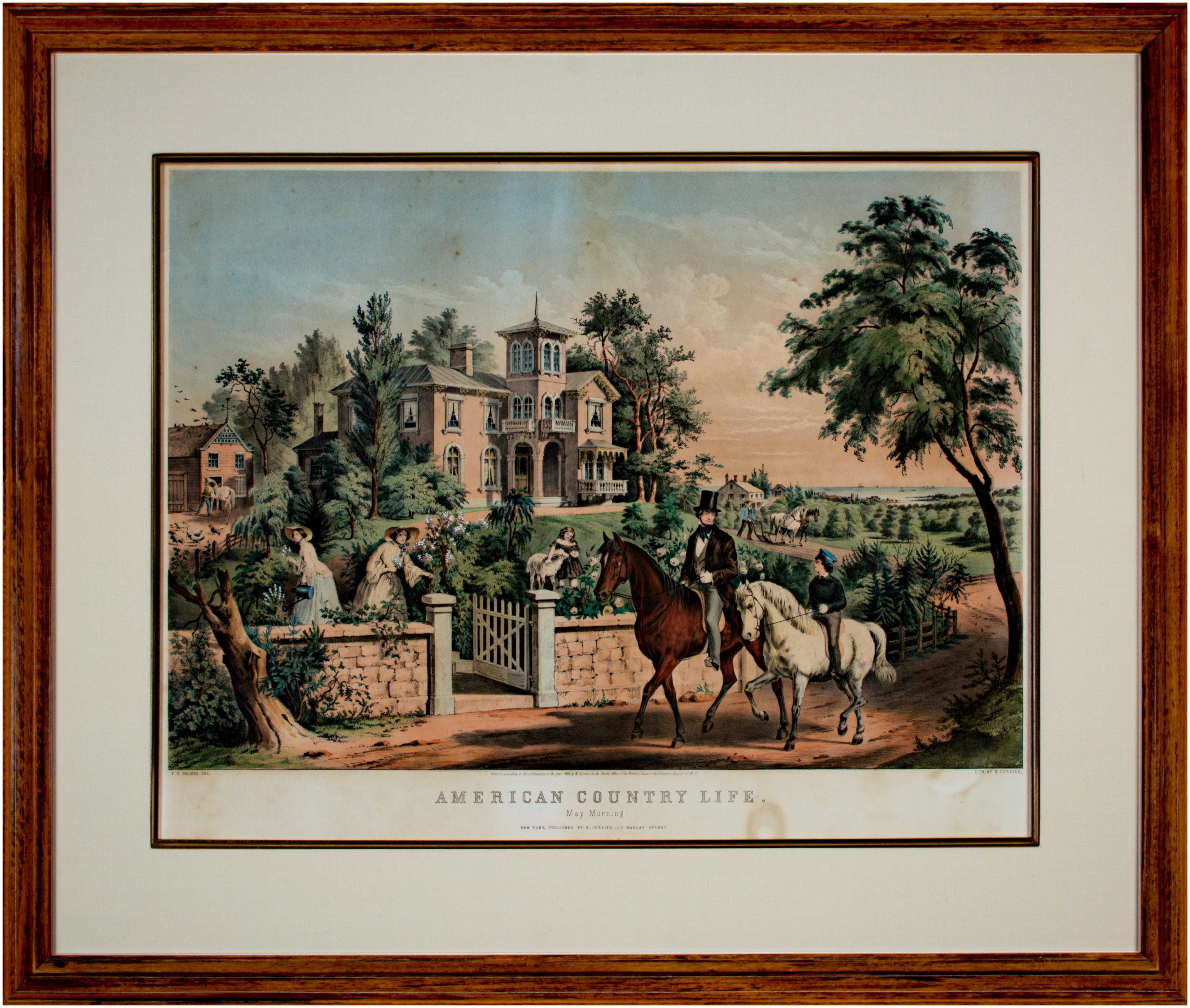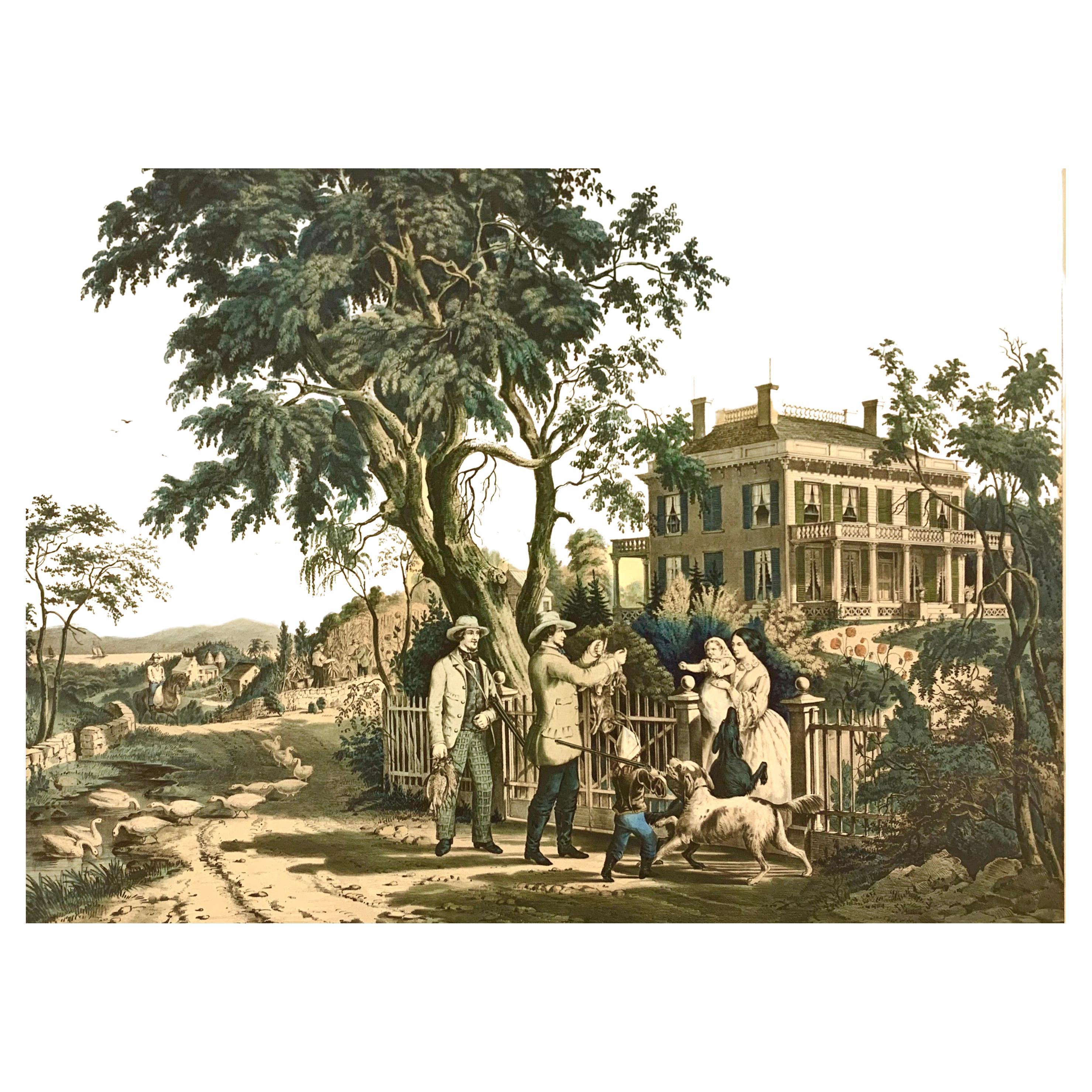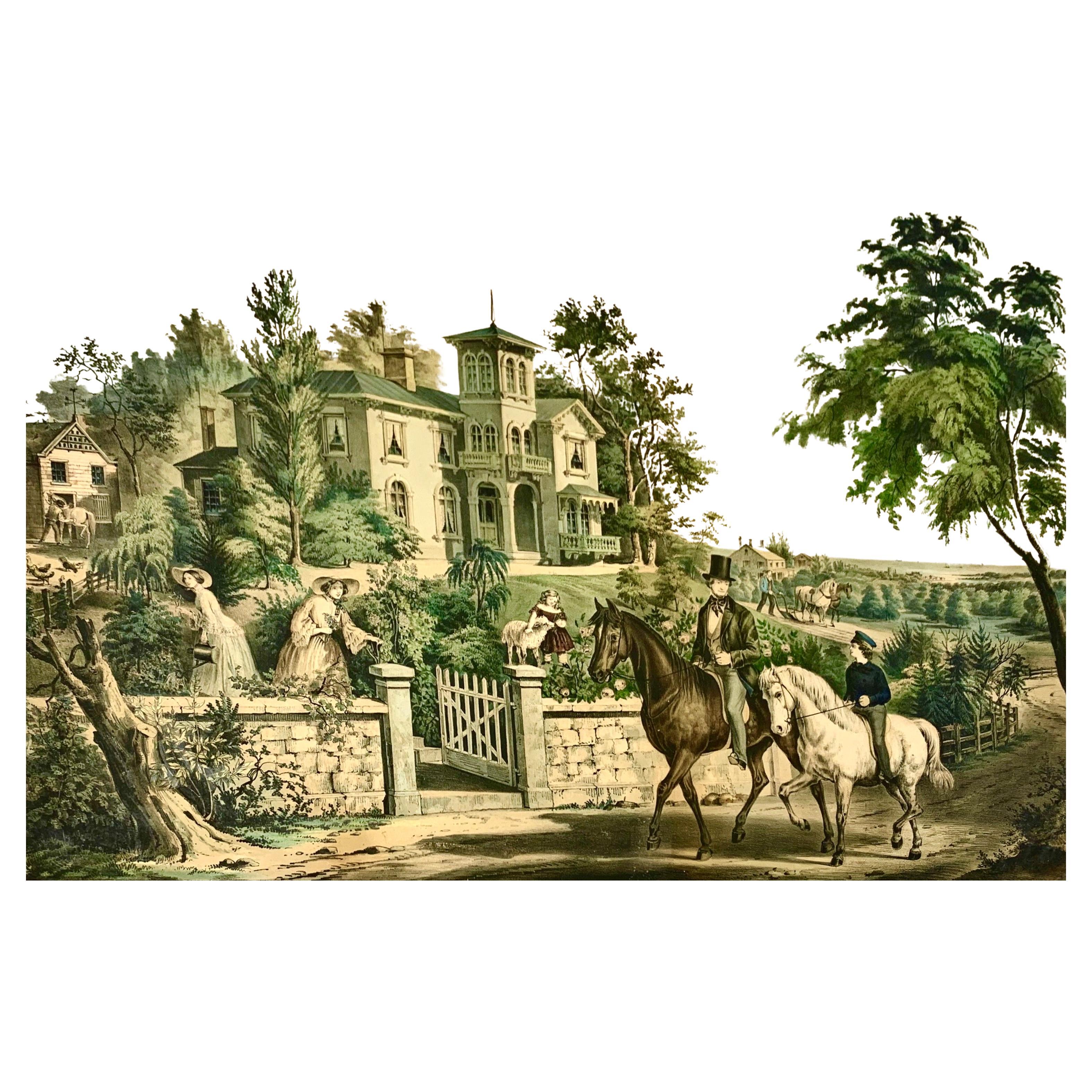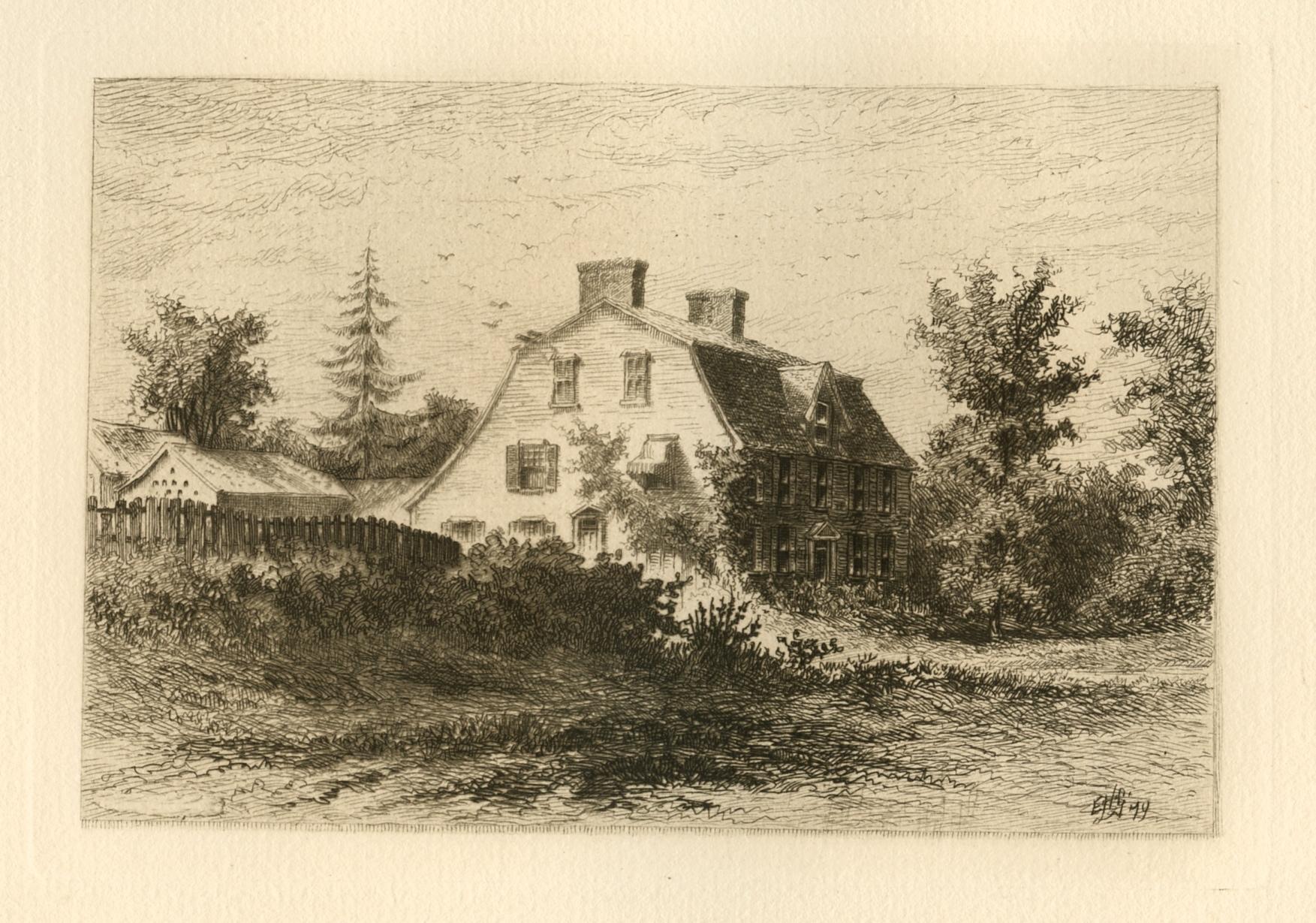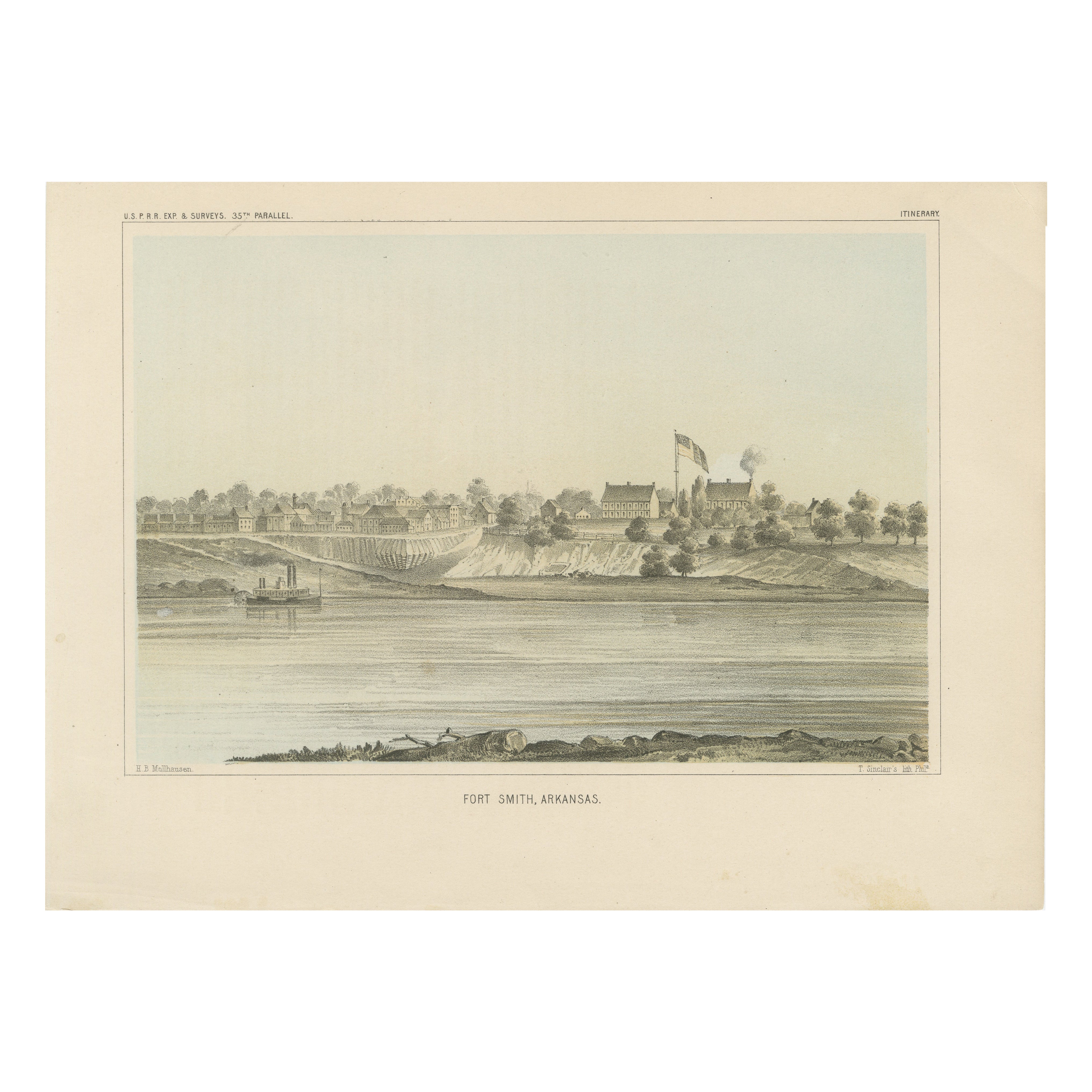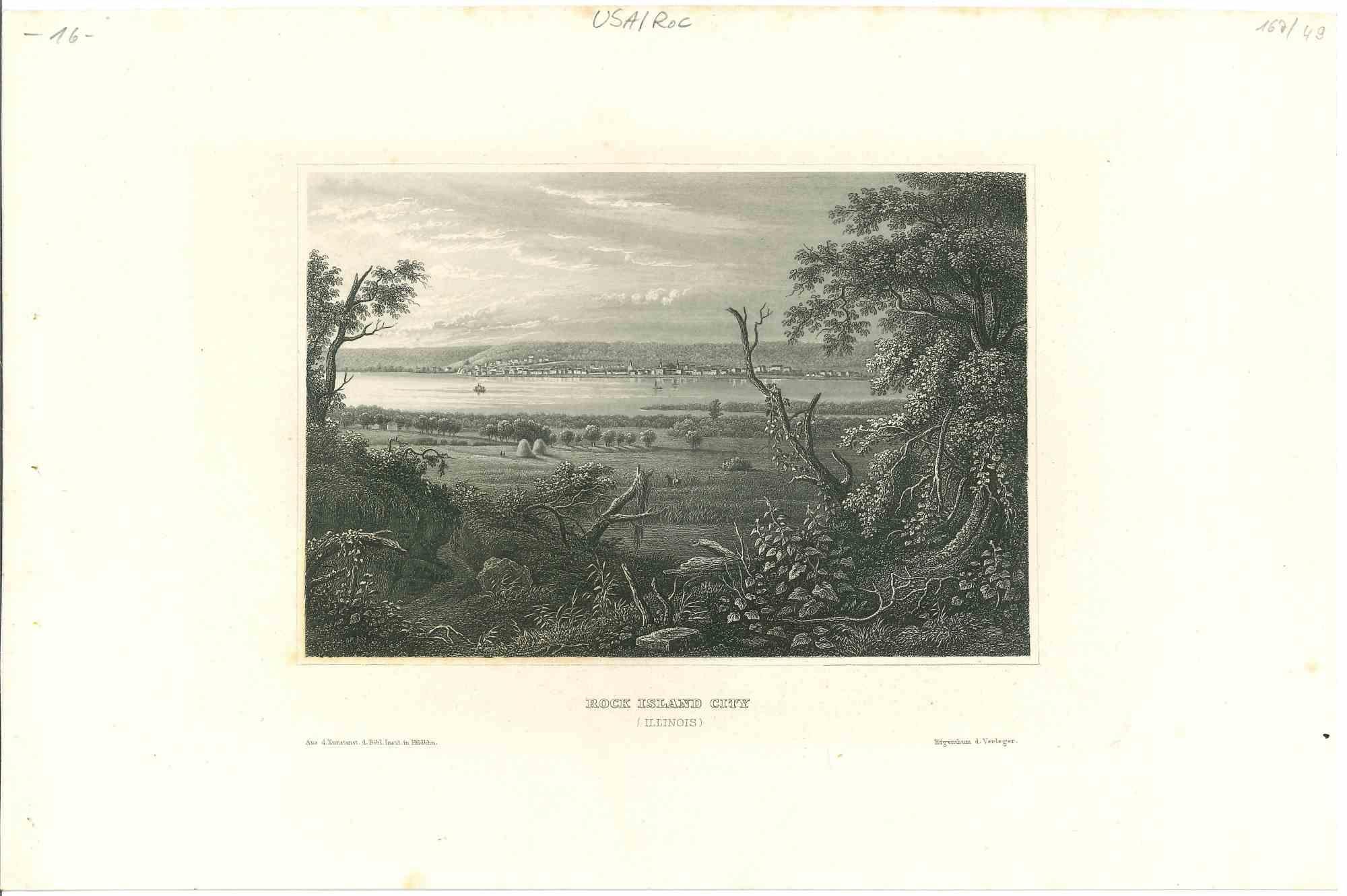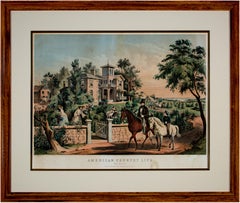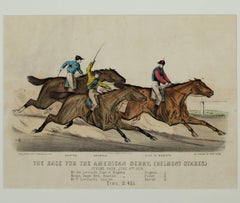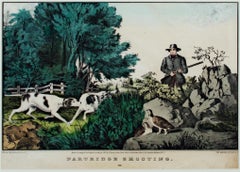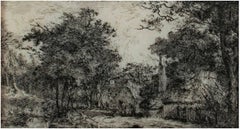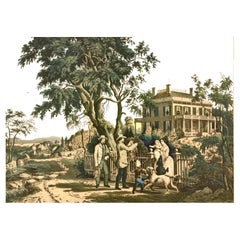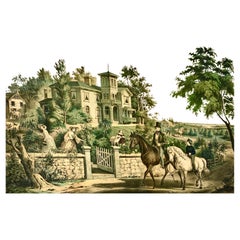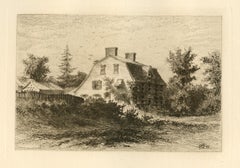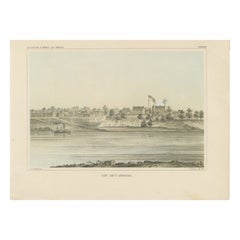Items Similar to "Birthplace of Henry Clay, Hanover County, VA, " Lithograph by Kelloggs & Thayer
Want more images or videos?
Request additional images or videos from the seller
1 of 9
Kelloggs & Thayer"Birthplace of Henry Clay, Hanover County, VA, " Lithograph by Kelloggs & Thayerc. 1870s
c. 1870s
$2,250
£1,718.78
€1,974.87
CA$3,217.02
A$3,544.40
CHF 1,834.80
MX$42,675.53
NOK 23,232.97
SEK 21,825.91
DKK 14,744.92
About the Item
"Birthplace of Henry Clay, Hanover County, Virginia" is an original hand-colored lithograph by Kelloggs & Thayer. The piece features a homestead and farm animals.
11 1/2" x 14 1/4" art
19 3/8" x 23" frame
From about 1830 through the rest of the century, the Kellogg brothers, in various partnerships among themselves and with others, published popular lithographs in Hartford, Connecticut. These firms issued the second largest number of decorative prints intended for the American public, surpassed only by their New York rivals, Currier & Ives, producing thousands of lithographs, most hand-colored, which ended up in the homes and work places of Americans. The Kelloggs' prints were typical of the popular print style: colorful, affordable and with images covering much the same range of topics as those of their New York counterpart. Subjects included portraits, historical events, scenes of daily life, views, religious themes, politics, sports, animals, sentimental images and any other topic that might be of interest to the American public.
- Creator:Kelloggs & Thayer
- Creation Year:c. 1870s
- Dimensions:Height: 19.375 in (49.22 cm)Width: 23 in (58.42 cm)
- Medium:
- Movement & Style:
- Period:
- Condition:
- Gallery Location:Milwaukee, WI
- Reference Number:Seller: 8763g1stDibs: LU60533654981
About the Seller
4.9
Gold Seller
Premium sellers maintaining a 4.3+ rating and 24-hour response times
Established in 1966
1stDibs seller since 2017
451 sales on 1stDibs
Typical response time: 2 hours
- ShippingRetrieving quote...Shipping from: Milwaukee, WI
- Return Policy
Authenticity Guarantee
In the unlikely event there’s an issue with an item’s authenticity, contact us within 1 year for a full refund. DetailsMoney-Back Guarantee
If your item is not as described, is damaged in transit, or does not arrive, contact us within 7 days for a full refund. Details24-Hour Cancellation
You have a 24-hour grace period in which to reconsider your purchase, with no questions asked.Vetted Professional Sellers
Our world-class sellers must adhere to strict standards for service and quality, maintaining the integrity of our listings.Price-Match Guarantee
If you find that a seller listed the same item for a lower price elsewhere, we’ll match it.Trusted Global Delivery
Our best-in-class carrier network provides specialized shipping options worldwide, including custom delivery.More From This Seller
View All19th century color lithograph landscape figures horseback house scene trees sky
By Nathaniel Currier
Located in Milwaukee, WI
The present print is one of several examples produced for Nathaniel Currier by his longtime collaborator Frances F. "Fanny" Palmer. Harry T. Peters wrote of her: "There is no more interesting and appealing character among the group of artists who worked for Currier & Ives than Fanny Palmer. In an age when women, well-bred women in particular, did not generally work for a living Fanny Palmer for years did exacting, full-time work in order to support a large and dependent family ... Her work ... had great charm, homeliness, and a conscientious attention to detail."
One of a series of four prints showing American country life in different seasons, the image presents the viewer with a picturesque view of a successful American farm. In the foreground, a gentleman rides a horse with a young boy before a respectable Italianate country house. Two women and a young girl pick flowers in the garden and several farm workers attend to their duties. Beyond are other homes and a city on the coast.
16.63 x 23.75 inches, artwork
28.13 x 33.38 inches, frame
Entitled bottom center "American Country Life - May Morning"
Signed in the stone, lower left "F.F. Palmer, Del."
Signed in the stone, lower right "Lith. by N. Currier"
Copyrighted lower center "Entered according to Act of Congress in the year 1855 by N. Currier in the Clerk's office of the Southern District of N.Y."
Inscribed bottom center "New York, Published by N. Currier 152 Nassau Street"
Framed to conservation standards using silk-lined 100 percent rag matting and Museum Glass with a gold gilded liner, all housed in a stained wood moulding.
Nathaniel Currier was a tall introspective man with a melancholy nature. He could captivate people with his piercing stare or charm them with his sparkling blue eyes. Nathaniel was born in Roxbury, Massachusetts on March 27th, 1813, the second of four children. His parents, Nathaniel and Hannah Currier, were distant cousins who lived a humble yet spartan life. When Nathaniel was eight years old, tragedy struck. Nathaniel’s father unexpectedly passed away leaving Nathaniel and his eleven-year-old brother Lorenzo to provide for the family. In addition to their mother, Nathaniel and Lorenzo had to care for six-year-old sister Elizabeth and two-year-old brother Charles. Nathaniel worked a series of odd jobs to support the family, and at fifteen, he started what would become a life-long career when he apprenticed in the Boston lithography shop of William and John Pendleton.
A Bavarian gentleman named Alois Senefelder invented lithography just 30 years prior to young Nat Currier’s apprenticeship. While under the employ of the brothers Pendleton, Nat was taught the art of lithography by the firm’s chief printer, a French national named Dubois, who brought the lithography trade to America.
Lithography involves grinding a piece of limestone flat and smooth then drawing in mirror image on the stone with a special grease pencil. After the image is completed, the stone is etched with a solution of aqua fortis leaving the greased areas in slight relief. Water is then used to wet the stone and greased-ink is rolled onto the raised areas. Since grease and water do not mix, the greased-ink is repelled by the moisture on the stone and clings to the original grease pencil lines. The stone is then placed in a press and used as a printing block to impart black on white images to paper.
In 1833, now twenty-years old and an accomplished lithographer, Nat Currier left Boston and moved to Philadelphia to do contract work for M.E.D. Brown, a noted engraver and printer. With the promise of good money, Currier hired on to help Brown prepare lithographic stones of scientific images for the American Journal of Sciences and Arts. When Nat completed the contract work in 1834, he traveled to New York City to work once again for his mentor John Pendleton, who was now operating his own shop located at 137 Broadway. Soon after the reunion, Pendleton expressed an interest in returning to Boston and offered to sell his print shop to Currier. Young Nat did not have the financial resources to buy the shop, but being the resourceful type he found another local printer by the name of Stodart. Together they bought Pendleton’s business.
The firm ‘Currier & Stodart’ specialized in "job" printing. They produced many different types of printed items, most notably music manuscripts for local publishers. By 1835, Stodart was frustrated that the business was not making enough money and he ended the partnership, taking his investment with him. With little more than some lithographic stones, and a talent for his trade, twenty-two year old Nat Currier set up shop in a temporary office at 1 Wall Street in New York City. He named his new enterprise ‘N. Currier, Lithographer’
Nathaniel continued as a job printer and duplicated everything from music sheets to architectural plans. He experimented with portraits, disaster scenes and memorial prints, and any thing that he could sell to the public from tables in front of his shop. During 1835 he produced a disaster print Ruins of the Planter's Hotel, New Orleans, which fell at two O’clock on the Morning of the 15th of May 1835, burying 50 persons, 40 of whom Escaped with their Lives. The public had a thirst for newsworthy events, and newspapers of the day did not include pictures. By producing this print, Nat gave the public a new way to “see” the news. The print sold reasonably well, an important fact that was not lost on Currier.
Nat met and married Eliza Farnsworth in 1840. He also produced a print that same year titled Awful Conflagration of the Steamboat Lexington in Long Island Sound on Monday Evening, January 18, 1840, by which melancholy occurrence over One Hundred Persons Perished. This print sold out very quickly, and Currier was approached by an enterprising publication who contracted him to print a single sheet addition of their paper, the New York Sun. This single page paper is presumed to be the first illustrated newspaper ever published.
The success of the Lexington print launched his career nationally and put him in a position to finally lift his family up. In 1841, Nat and Eliza had their first child, a son they named Edward West Currier. That same year Nat hired his twenty-one year old brother Charles and taught him the lithography trade, he also hired his artistically inclined brother Lorenzo to travel out west and make sketches of the new frontier as material for future prints. Charles worked for the firm on and off over the years, and invented a new type of lithographic crayon which he patented and named the Crayola. Lorenzo continued selling sketches to Nat for the next few years.
In 1843, Nat and Eliza had a daughter, Eliza West Currier, but tragedy struck in early 1847 when their young daughter died from a prolonged illness. Nat and Eliza were grief stricken, and Eliza, driven by despair, gave up on life and passed away just four months after her daughter’s death.
The subject of Nat Currier’s artwork changed following the death of his wife and daughter, and he produced many memorial prints and sentimental prints during the late 1840s. The memorial prints generally depicted grief stricken families posed by gravestones (the stones were left blank so the purchasers could fill in the names of the dearly departed). The sentimental prints usually depicted idealized portraits of women and children, titled with popular Christian names of the day.
Late in 1847, Nat Currier married Lura Ormsbee, a friend of the family. Lura was a self-sufficient woman, and she immediately set out to help Nat raise six-year-old Edward and get their house in order. In 1849, Lura delivered a son, Walter Black Currier, but fate dealt them a blow when young Walter died one year later. While Nat and Lura were grieving the loss of their new son, word came from San Francisco that Nat’s brother Lorenzo had also passed away from a brief illness. Nat sank deeper into his natural quiet melancholy. Friends stopped by to console the couple, and Lura began to set an extra place at their table for these unexpected guests. She continued this tradition throughout their lives.
In 1852, Charles introduced a friend, James Merritt Ives, to Nat and suggested he hire him as a bookkeeper. Jim Ives was a native New Yorker born in 1824 and raised on the grounds of Bellevue Hospital where his father was employed as superintendent. Jim was a self-trained artist and professional bookkeeper. He was also a plump and jovial man, presenting the exact opposite image of his new boss.
Jim Ives met Charles Currier through Caroline Clark, the object of Jim’s affection. Caroline’s sister Elizabeth was married to Charles, and Caroline was a close friend of the Currier family. Jim eventually proposed marriage to Caroline and solicited an introduction to Nat Currier, through Charles, in hopes of securing a more stable income to support his future wife.
Ives quickly set out to improve and modernize his new employer’s bookkeeping methods. He reorganized the firm’s sizable inventory, and used his artistic skills to streamline the firm’s production methods. By 1857, Nathaniel had become so dependent on Jims’ skills and initiative that he offered him a full partnership in the firm and appointed him general manager. The two men chose the name ‘Currier & Ives’ for the new partnership, and became close friends.
Currier & Ives produced their prints in a building at 33 Spruce Street where they occupied the third, fourth and fifth floors. The third floor was devoted to the hand operated printing presses that were built by Nat's cousin, Cyrus Currier, at his shop Cyrus Currier & Sons in Newark, NJ. The fourth floor found the artists, lithographers and the stone grinders at work. The fifth floor housed the coloring department, and was one of the earliest production lines in the country. The colorists were generally immigrant girls, mostly German, who came to America with some formal artistic training. Each colorist was responsible for adding a single color to a print. As a colorist finished applying their color, the print was passed down the line to the next colorist to add their color. The colorists worked from a master print displayed above their table, which showed where the proper colors were to be placed. At the end of the table was a touch up artist who checked the prints for quality, touching-in areas that may have been missed as it passed down the line. During the Civil War, demand for prints became so great that coloring stencils were developed to speed up production.
Although most Currier & Ives prints were colored in house, some were sent out to contract artists. The rate Currier & Ives paid these artists for coloring work was one dollar per one hundred small folios (a penny a print) and one dollar per one dozen large folios. Currier & Ives also offered uncolored prints to dealers, with instructions (included on the price list) on how to 'prepare the prints for coloring.' In addition, schools could order uncolored prints from the firm’s catalogue to use in their painting classes.
Nathaniel Currier and James Merritt Ives attracted a wide circle of friends during their years in business. Some of their more famous acquaintances included Horace Greeley, Phineas T. Barnum, and the outspoken abolitionists Rev. Henry Ward, and John Greenleaf Whittier (the latter being a cousin of Mr. Currier).
Nat Currier and Jim Ives described their business as "Publishers of Cheap and Popular Pictures" and produced many categories of prints. These included Disaster Scenes, Sentimental Images, Sports, Humor, Hunting Scenes, Politics, Religion, City and Rural Scenes, Trains, Ships, Fire Fighters, Famous Race Horses, Historical Portraits, and just about any other topic that satisfied the general public's taste. In all, the firm produced in excess of 7500 different titles, totaling over one million prints produced from 1835 to 1907.
Nat Currier retired in 1880, and signed over his share of the firm to his son Edward. Nat died eight years later at his summer home 'Lion’s Gate' in Amesbury, Massachusetts. Jim Ives remained active in the firm until his death in 1895, when his share of the firm passed to his eldest son, Chauncey.
In 1902, faced will failing health from the ravages of Tuberculosis, Edward Currier sold his share of the firm to Chauncey Ives...
Category
Mid-19th Century Romantic Figurative Prints
Materials
Watercolor, Lithograph
19th century color lithograph horses figures dynamic landscape
By Currier & Ives
Located in Milwaukee, WI
"The Race for the American Derby (Belmont Stakes)" is an original hand-colored lithograph published by Currier & Ives. It depicts three racehorses and their jockeys running in the Belmont Stakes. The caption for this lithograph says, "Spartan. Bramble. Duke of Magenta. Jerome Park, June 8th 1878. Mr. Geo. Lorillard's Duke of Magenta.....Hughes, 1....Messrs.Dwyer Bro's Bramble......Fisher, 2....Mr. P. Lorillard's Spartan.....Barrett, 3..... TIME 2:43 1/2."
12 7/8" x 16 7/8" art
21 7/8" x 25 7/8" frame
Currier & Ives produced their prints in a building at 33 Spruce Street where they occupied the third, fourth and fifth floors. The third floor was devoted to the hand operated printing presses that were built by Nat's cousin, Cyrus Currier, at his shop Cyrus Currier & Sons in Newark, NJ. The fourth floor found the artists, lithographers and the stone grinders...
Category
1870s Animal Prints
Materials
Lithograph
19th century color lithograph watercolor landscape figurative animal print
By Nathaniel Currier
Located in Milwaukee, WI
The present hand-colored lithograph presents the viewer with a hunting scene in a picturesque landscape. In the foreground, a man approaches two partridges as his two pointers prepare to flush them out. Beyond, a white fence draws our eyes to the homestead in the distance. Images like this one show how people in the United States were trying to identify themselves as a new nation in the North American landscape - as separate from their European counterparts but with similar similar and specific wildlife and magesties of nature. It also identifies hunting in this landscape as an American pastime.
9.25 x 12.5 inches, artwork
18.38 x 22 inches, frame
Entitled bottom center "Partridge Shooting...
Category
Mid-19th Century Romantic Figurative Prints
Materials
Watercolor, Lithograph
"Country Inn by the Pond, " Etching by John Thomas Smith
By John Thomas Smith
Located in Milwaukee, WI
"Country Inn by the Pond" is an original etching by John Thomas Smith. It depicts a cozy building surrounded by trees and vegetation and next to a pond.
3" x 5 1/4" art
16" x 18 1/...
Category
1790s Old Masters Landscape Prints
Materials
Etching
19th century engraving figurative landscape Victorian urban city scene signed
By Winslow Homer
Located in Milwaukee, WI
"SEESAW--Gloucester, Massachusetts" is an original wood engraving after Winslow Homer. The artist initialed the piece in the lower right. This print depicts six children on a seesaw ...
Category
1870s Academic Figurative Prints
Materials
Engraving
18th century landscape etching pastoral house nature scene detailed ink trees
By John Thomas Smith
Located in Milwaukee, WI
"Near Mill Hill, Gravesend" is an original etching by John Thomas Smith. It depicts a cottage and farmstead with a few small figures. The piece is titled on ...
Category
1790s Old Masters Landscape Prints
Materials
Etching
You May Also Like
Nathan Currier Lithograph "October Afternoon" American Country Life Series C1855
By Currier & Ives
Located in Incline Village, NV
"October Afternoon" Maintains the appropriate markings along with "New York, Published by N. Currier 152 Nassau Street.
(The firm was located here in lower Manhattan from 1837-1872)
The lithograph illustrates two men and their dog with young son (hunting rifle over shoulder) in tow, returning from the rabbit hunt with their catch being presented to the lady of the house with baby in arms. The gated mansion is in the background while geese float upon the fertile pond in the background.
In addition to the Amon Carter Museum in Dallas, an example of "Pleasures of Winter" is in:
The Metropolitan Museum of Art (Bequest of Adele S. Colgate, 1962)
Museum of Fine Arts Boston (Donated by Lee M. Friedman)
The Library of Congress
The Yale University Art Gallery (Gift of Mabel Brady Garvan Collection)
Dimensions: actual= 16 1/2" h x 23 13/16" w
matte= 19 1/2" h x 25 1/4" w
folio= 21 1/4" h x 27 3/4" w
with frame= 26 1/4" h x 32 1/4" w
frame= 1 1/4" burl bird's eye maple
It is in very good all original condition; and housed and professionally mounted in a fine quality and attractive bird's eye maple wooden frame with preservation backing and frontal protective glass (important when dealing with 170 year old lithographs); it is the rare and desirable Currier large folio sheet example in fine original color. There is some slight foxing to the cream border and minor fading (see images),
The larger folios are more rare because they appealed to the wealthier sector of the population and were more expensive, thus fewer were made, albeit, knowing their more discerning customer base, there was more attention given to detail; hand coloring, and quality for example. This example has been framed and housed in museum quality conservation backing for over 80 years. I have had it professionally taken apart and I inspected the folio visually, and examined it with a black light and loop; as a result, I guarantee and can attest to the accuracy of my description of the lithograph. I then had the folio professionally remounted in it's original frame with an upgraded preservation backing (see images of original folios out of frame and for confirmation of inspection). This lithograph has no tears, no touch up paint, and no glued or taped repairs.
This is one of the four iconic and highly desirable set of lithographs made by Nathaniel Currier (1813-1888) dated 1855 from the American Country Life series. They are named;
Spring "May Morning";
Summer "Summer Evening";
Fall ""October Afternoon"; and
Winter "Pleasures of Winter".
The lithograph was produced from the painting of well known artist Frances (Fanny) Flora (Bond Palmer (1812-1876). She painted typical American scenes of daily American life that were used by Currier for years to come. She was an accomplished artist by the time she migrated to the United States from England, and Currier commissioned her to do the country scenes for this series. Each of the original images are toned lithographs with applied hand painted watercolor.
The lithograph reflects an affluent life style, showcasing grandiose homes and glamorizing the rural way of living as urban areas became more densely populated with the tidal wave and arrival of immigrants. Nathaniel Currier began his lithograph business in 1835 with hand colored images portraying outdoor panoramic, historical, pastoral, and landmark scenes and events, with which the middle class and the wealthy sought to decorate their houses. James Ives (1824-1895) was his accountant) and would join him later in 1857 to help run the business.
The hand painted lithograph is embellished with script text in the bottom margin of the folio "Entered according to art of congress in the year 1855 by N. Currier in the clerk's office of the southern district of N.Y."
"F.F Palmer...
Category
Antique 1850s Victorian Prints
Materials
Paper
Nathaniel Currier Lithograph "May Morning" American Country Life Series C. 1855
By Currier & Ives
Located in Incline Village, NV
This lithograph portrays a pleasant scene of a man in a top hat atop a handsome dark horse, with a boy riding a white horse (presumably father and son) in front of a country estate, while women gather as they water flowers, and children play with a lamb in the foreground. A man plows a field; while a horse is being groomed near the stable in the background. Afar and to the right is the sea dotted with ships here and there. The folio is mounted on cardboard and set in the matte.
It is in very good all original condition; and housed and professionally mounted in a fine quality and attractive bird's eye maple wooden frame with preservation backing and frontal protective glass (important when dealing with 170 year old lithographs); it is the rare and desirable Currier large folio sheet example in fine original color. There is some toning and slight fading,
The larger folios are more rare because they appealed to the wealthier sector of the population and were more expensive, thus fewer were made, albeit, knowing their more discerning customer base, there was more attention given to detail; hand coloring, and quality for example. This example has been framed and housed in museum quality conservation backing for over 80 years. I have had it professionally taken apart and I inspected the folio visually, and examined it with a black light and loop; as a result, I guarantee and can attest to the accuracy of my description of the lithograph. I then had the folio professionally remounted in their original frame with an upgraded preservation backing (see images of original folios out of frame and for confirmation of inspection). This lithograph has no tears, no touch up paint, and no glued or taped repairs.
This is one of the four iconic and highly desirable set of lithographs made by Nathaniel Currier (1813-1888) dated 1855 from the American Country Life series. They are named;
Spring "May Morning";
Summer "Summer Evening";
Fall ""October Afternoon"; and
Winter "Pleasures of Winter".
The lithograph was produced from the painting of well known artist Frances (Fanny) Flora (Bond Palmer (1812-1876). She painted typical American scenes of daily American life that were used by Currier for years to come. She was an accomplished artist by the time she migrated to the United States from England, and Currier commissioned her to do the country scenes for this series. Each of the original images are toned lithographs with applied hand painted watercolor.
The lithograph reflects an affluent life style, showcasing grandiose homes and glamorizing the rural way of living as urban areas became more densely populated with the tidal wave and arrival of immigrants. Nathaniel Currier began his lithograph business in 1835 with hand colored images portraying outdoor panoramic, historical, pastoral, and landmark scenes and events, with which the middle class and the wealthy sought to decorate their houses. James Ives (1824-1895) was his accountant) and would join him later in 1857 to help run the business.
The hand painted lithograph is embellished with script text in the bottom margin of the folio "Entered according to art of congress in the year 1855 by N. Currier in the clerk's office of the southern district of N.Y."
"F.F Palmer...
Category
Antique 1850s American Victorian Prints
Materials
Paper
"Home of Nathaniel Hawthorne" original etching
By Edmund Henry Garrett
Located in Henderson, NV
Medium: original etching. This impression was published in Boston in 1887 by Estes and Lauriat for the "Nature and Art" portfolio and is printed on cream laid paper. Size: 4 3/4 x 6 ...
Category
1880s Prints and Multiples
Materials
Etching
Fort Smith, Arkansas – Rare 19th Century Lithograph of Frontier History, 1856
Located in Langweer, NL
Title: Fort Smith, Arkansas – Rare 19th Century Lithograph of Frontier History
Description:
This finely detailed lithograph showcases Fort Smith, Arkansas, as it appeared in the m...
Category
Antique 1850s Prints
Materials
Paper
Ancient View of Rock Island City - Original Lithograph - 1850
Located in Roma, IT
Ancient View of Rock Island City is an original modern artwork realized in Italy in the first half of the 19th Century.
Original Lithograph on Ivory Paper...
Category
1850s Modern Figurative Prints
Materials
Lithograph
Original Antique Print of Albany, New York, circa 1840
Located in St Annes, Lancashire
Great print of Albany, New York
Steel engraving by Daumerlang after Wall
Published circa 1840
Unframed.
Category
Antique 1840s German Other Prints
Materials
Paper
More Ways To Browse
Antique Clay Art
Antique Farm Animals
Cat Clay Sculpture
Ceramic Totem Pole
Christmas Star
Coffee Poster
Contemporary Ceramic Animal Sculpture
Fred Meijer
Frederick Hart Bronze
Grouse Art
Horror Art
Italian Fruit Painting
Judith Holofernes
Kaws Red
Kaws Small Lie
Miami Street Art
Nebraska Artist
Painting Spanish Scene
